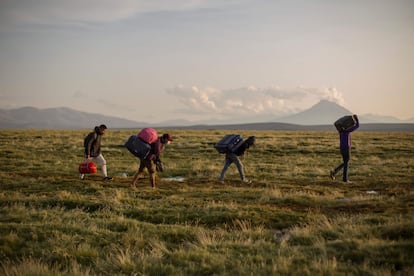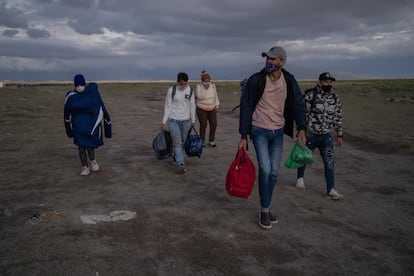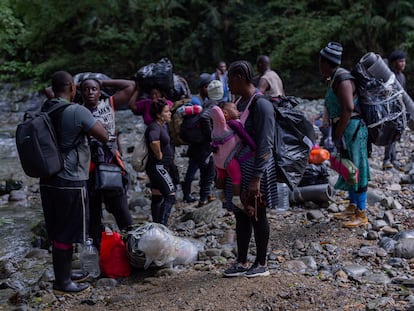Violence, extortion, and regret. This is what migrating 3,000 miles from Bolivia to Mexico is like
The story of Purita Valle reflects the suffering of migrants in Central America and Mexico, according to the latest report from Doctors Without Borders


Purita Valle has traveled 3,400 miles over land from the Bolivian city of Santa Cruz to the Mexican city of Juchitán, in the state of Oaxaca. To do this, she used the $10,000 she got from selling the little she had when she lived in Chile. Each mile has cost $1.25, and now he only has $200 left. But the economic aspect is never the most painful thing. The 35-year-old Bolivian and her family were three of the more than 500,000 people who migrated from South America through the Darién jungle, according to Panamanian immigration authorities. Then, in Central America, migrants suffer robberies, threats, torture, kidnappings, and extortion, as reflected in the latest report and testimony shared with EL PAÍS by Doctors Without Borders (MSF).
Looking at it over time and especially space, leaving what Valle considered her home in Santiago, Chile, with her 55-year-old husband and 3-year-old son was a huge mistake. “I worked during the day. My son went to kindergarten while I worked. But false friendships brainwashed us by saying, ‘come here,’” she explains about why she decided to leave.
There were other reasons behind why this diabetic woman with high blood pressure wanted to cross the continent. “We didn’t have much money anymore, so we decided to sell the house and the truck to supposedly go to the United States,” she recalls. She is an exceptional case, since few people from Bolivia arrive in Mexico. Data from Mexico’s National Migration Institute (INM) shows only 30 people with Bolivian nationality have received humanitarian visas of the more than 137,000 issued.
After leaving Chile, Valle decided to stop by her native Santa Cruz to see her family. From there began an odyssey that took her first across Peru, Ecuador, and then Colombia, countries in which the trip was “expensive but normal.” Then came the death trap of the Darién jungle, Panama, Costa Rica, Nicaragua, Honduras, and Guatemala to finally reach Mexico. This odyssey — which for an ordinary traveler would be one of the greatest adventures of their life — was a torment for Valle just because she was a migrant. “I feel bad. I feel tired, bored, upset with myself,” she says.
In its report, MSF has placed emphasis on mental health. After caring for more than 130,000 migrants — 8,000 of whom received psychological care — in several countries in Central America and Mexico, the poor emotional state of entire migrant families stands out to the organization. The main reason is that seven out of every 10 migrants have witnessed or have been a victim of violence along the way.
Valle breaks down in tears as she remembers “the horror” of the dangerous Darién jungle. “I didn’t experience it, but I saw girls being taken away,” she explains. MSF defines rape as one of the “rawest aspects” of violence against migrants. “Touching and rape are carried out in front of other people,” says Luis Eguiluz, the head of the NGO’s mission in Colombia and Panama. This year, MSF has given assistance to 504 survivors of sexual violence in Central America and Mexico.
The upsurge in violence during the trip is also due to the fact that the migrant profile has mutated since the pandemic. Since 2020, women, children, the elderly, people from the LGBTQ+ community, and entire families have been forced to leave their countries for financial or social reasons, or due to repression by their governments. Although of course, the fault lies not with the traveler, but with the aggressor, who does not always hide outside the law. “Abuse against migrants and the negligence of institutions in responding to their needs are a constant throughout the region,” says Camilo Vélez, MSF’s head of mission in Mexico and Central America.
Valle shares an anecdote that explains the influence of Mexican cartels on human trafficking, which is suffered mostly by migrants. “We were afraid. Eight kilometers from a small town, a taxi driver told us, ‘Come on, I’ll take you’. He said he was going to charge us 30 pesos — it costs 200 pesos per head in trucks. On the way we were stopped by men with weapons who told the taxi driver, ‘Leave them here right now. You know you mustn’t take anyone,’” Valle recalls.

The NGO also points to the role that the United States has in this unprecedented migration crisis in Central America and Mexico. The country has broken the record of asylum applications for the last 10 years, with more than 137,000, according to the Mexican Commission for Refugee Assistance. “The United States government missed an opportunity to rebuild its asylum system. After the inevitable end of Title 42, which allowed the expulsion of nearly two million people in the three years that it was in force, the U.S. Administration decided to strengthen the application of the Migration Law known as Title 8,” MSF explains in its report.
The Bolivian woman no longer cares about the titles that govern the U.S. immigration policy. “People bore me, even my own son bores me, but it’s not his fault either.” The trip has destroyed her mind. She thinks about the decision she made in Chile again and again. “You supposedly want to make progress and live a better life, but it’s a lie. You come [to the United States] and buy the best phone, the best car… And for what? What about everything that you went through?”
Sign up for our weekly newsletter to get more English-language news coverage from EL PAÍS USA Edition
Tu suscripción se está usando en otro dispositivo
¿Quieres añadir otro usuario a tu suscripción?
Si continúas leyendo en este dispositivo, no se podrá leer en el otro.
FlechaTu suscripción se está usando en otro dispositivo y solo puedes acceder a EL PAÍS desde un dispositivo a la vez.
Si quieres compartir tu cuenta, cambia tu suscripción a la modalidad Premium, así podrás añadir otro usuario. Cada uno accederá con su propia cuenta de email, lo que os permitirá personalizar vuestra experiencia en EL PAÍS.
¿Tienes una suscripción de empresa? Accede aquí para contratar más cuentas.
En el caso de no saber quién está usando tu cuenta, te recomendamos cambiar tu contraseña aquí.
Si decides continuar compartiendo tu cuenta, este mensaje se mostrará en tu dispositivo y en el de la otra persona que está usando tu cuenta de forma indefinida, afectando a tu experiencia de lectura. Puedes consultar aquí los términos y condiciones de la suscripción digital.
More information
Archived In
Últimas noticias
Most viewed
- Reinhard Genzel, Nobel laureate in physics: ‘One-minute videos will never give you the truth’
- Oona Chaplin: ‘I told James Cameron that I was living in a treehouse and starting a permaculture project with a friend’
- Pablo Escobar’s hippos: A serious environmental problem, 40 years on
- Chevy Chase, the beloved comedian who was a monster off camera: ‘Not everyone hated him, just the people who’ve worked with him’
- Why we lost the habit of sleeping in two segments and how that changed our sense of time










































